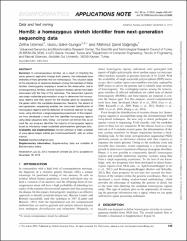| dc.contributor.author | Gormez, Zeliha | |
| dc.contributor.author | Bakir-Gungor, Burcu | |
| dc.contributor.author | Sagiroglu, Mahmut Samil | |
| dc.date.accessioned | 2020-02-14T12:59:03Z | |
| dc.date.available | 2020-02-14T12:59:03Z | |
| dc.date.issued | 2014 | en_US |
| dc.identifier.issn | 1367-4803 | |
| dc.identifier.other | eISSN: 1460-2059 | |
| dc.identifier.other | DOI: 10.1093/bioinformatics/btt686 | |
| dc.identifier.uri | https://hdl.handle.net/20.500.12573/170 | |
| dc.description | This work is supported by the Turkish State Planning Organization Research Grants, Grant Number: 108S420 and by UEKAE, BILGEM, The Scientific and Technology Research Council of Turkey (TUBITAK), Grant Number: K030-T439. | en_US |
| dc.description.abstract | In consanguineous families, as a result of inheriting the same genomic segments through both parents, the individuals have stretches of their genomes that are homozygous. This situation leads to the prevalence of recessive diseases among the members of these families. Homozygosity mapping is based on this observation, and in consanguineous families, several recessive disease genes have been discovered with the help of this technique. The researchers typically use single nucleotide polymorphism arrays to determine the homozygous regions and then search for the disease gene by sequencing the genes within this candidate disease loci. Recently, the advent of next-generation sequencing enables the concurrent identification of homozygous regions and the detection of mutations relevant for diagnosis, using data from a single sequencing experiment. In this respect, we have developed a novel tool that identifies homozygous regions using deep sequence data. Using*.vcf (variant call format) files as an input file, our program identifies the majority of homozygous regions found by microarray single nucleotide polymorphism genotype data. | en_US |
| dc.description.sponsorship | Turkish State Planning Organization Research Grants 108S420 Turkiye Bilimsel ve Teknolojik Arastirma Kurumu (TUBITAK) K030-T439 | en_US |
| dc.language.iso | eng | en_US |
| dc.publisher | OXFORD UNIV PRESS, GREAT CLARENDON ST, OXFORD OX2 6DP, ENGLAND | en_US |
| dc.relation.ispartofseries | Volume: 30 Issue: 3 Pages: 445-447; | |
| dc.rights | info:eu-repo/semantics/openAccess | en_US |
| dc.subject | MUTATION | en_US |
| dc.subject | GENE | en_US |
| dc.title | HomSI: a homozygous stretch identifier from next-generation sequencing data | en_US |
| dc.type | article | en_US |
| dc.contributor.department | AGÜ, Mühendislik Fakültesi, Bilgisayar Mühendisliği Bölümü | en_US |
| dc.contributor.institutionauthor | | |
| dc.identifier.doi | 10.1093/bioinformatics/btt686 | |
| dc.relation.publicationcategory | Makale - Uluslararası Hakemli Dergi - Kurum Öğretim Elemanı | en_US |


















